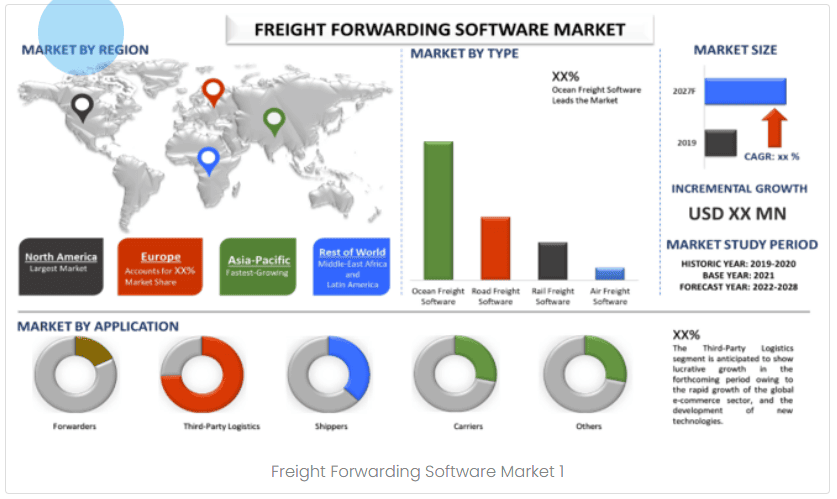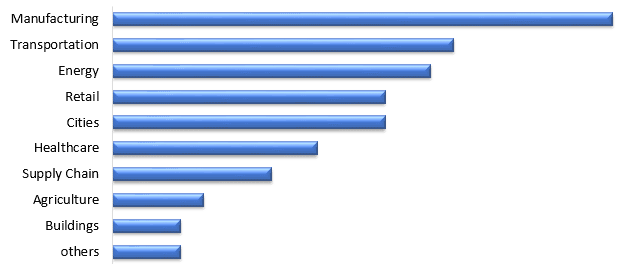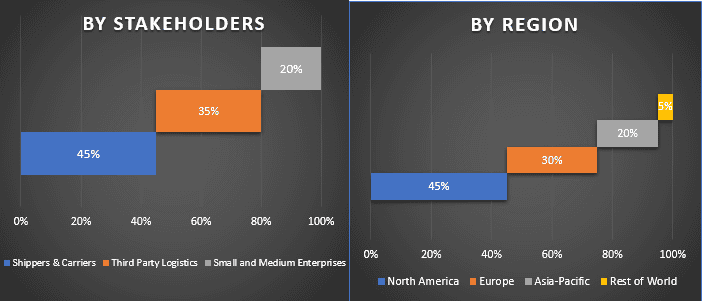- Accueil
- À propos de nous
- Industrie
- Services
- Lecture
- Contactez-nous
Marché des logiciels de transit de marchandises : Analyse et prévisions actuelles (2021-2027)
Accentuation sur le type (logiciels de fret ferroviaire, logiciels de fret routier, logiciels de fret maritime, logiciels de fret aérien) ; Application (logistique tierce partie, transitaires, expéditeurs et transporteurs, autres) ; Région/Pays

Les transitaires agissent comme intermédiaires pour le transport multimodal, ce qui apporte de nombreux avantages, tels qu'une sécurité accrue des marchandises et une livraison plus rapide. Le travail d'un transitaire implique le suivi du transport terrestre, l'entreposage, la préparation des documents d'expédition et d'exportation, le groupage de fret, la réservation de l'espace cargo, la négociation des frais de transport, l'assurance cargo et le dépôt des réclamations d'assurance. Les logiciels de transit de marchandises permettent la gestion ainsi que le contrôle du fret aérien, du fret terrestre, du fret maritime, de l'entrepôt, du transport, des douanes, et de l'intégrer à la gestion de la relation client (CRM), à la facturation et à la comptabilité financière en ligne depuis n'importe où, à tout moment, avec n'importe quel appareil. La demande de logiciels de transit de marchandises augmente en raison de la mise en œuvre du cloud et de l'analyse des mégadonnées dans diverses industries, de l'émergence de solutions avancées en matière de sécurité, de transport et de sûreté du fret.Par exemple, en 2021, Softlink Logistic Systems, le principal fournisseur de logiciels logistiques en Inde, a annoncé l'installation réussie de Logi-Sys, un logiciel de transit de marchandises en nuage de bout en bout qui fournit des systèmes de gestion de fret nationaux et internationaux faciles et efficaces pour les activités d'importation et d'exportation.Il offre des fonctionnalités sophistiquées pour aider les transitaires en intégrant l'ensemble des opérations, des succursales et de toutes les parties prenantes de la chaîne d'approvisionnement dans une seule application. En outre, les progrès des technologies de communication et de l'Internet des objets (IoT) intensifient également la croissance du marché. De plus, l'augmentation rapide des activités commerciales mondiales et la nécessité de contrôler le temps de transit sont le facteur clé qui stimule la croissance du marché.
Top 10 des domaines d'application de l'IoT, 2019

Aperçus présentés dans le rapport
« Parmi les types, le segment des logiciels de fret maritime détient la part la plus importante. »
Selon le type, le marché est fragmenté en logiciels de fret ferroviaire, logiciels de fret routier, logiciels de fret maritime et logiciels de fret aérien. Le segment des logiciels de fret maritime a dominé le marché en 2020 et devrait afficher une croissance lucrative au cours de la période à venir en raison du développement croissant des infrastructures, de l'augmentation du pouvoir d'achat et de la forte pénétration d'Internet. En outre, la forte préférence pour le transit maritime par plusieurs industries et l'augmentation des partenariats stratégiques favorisent également la croissance du segment. De plus, l'augmentation du marché mondial du commerce électronique transfrontalier intensifie le volume des chargements partiels (LCL), ce qui montre en outre un impact positif sur la croissance du segment du transit maritime. En outre, l'augmentation du débit des ports à conteneurs, l'augmentation du volume des échanges sur les routes commerciales européennes et le nombre croissant d'accords de libre-échange (ALE) stimulent la croissance du segment.Selon la Conférence des Nations Unies sur le commerce et le développement, plus de 70 % du commerce mondial en valeur et environ 80 % du commerce mondial en volume sont transportés par voie maritime et sont traités par les ports.
« Parmi les applications, la logistique tierce partie devrait croître au TCAC le plus élevé au cours de la période analysée. »
Selon l'application, le marché est fragmenté en logistique tierce partie, transitaires, expéditeurs et transporteurs, et autres. Le segment de la logistique tierce partie devrait afficher une croissance lucrative au cours de la période à venir en raison de la croissance rapide du secteur mondial du commerce électronique et du développement de nouvelles technologies. L'accent accru mis sur l'externalisation de l'activité logistique par les expéditeurs pour améliorer leur rentabilité et leurs opérations stimule la croissance du segment.Selon la société de recherche et de conseil Armstrong & Associates Inc., le marché mondial de la logistique s'élevait à 9,6 billions de dollars en 2018, et le transport routier représentait 43 % du total des coûts logistiques à l'échelle mondiale.
« L'Amérique du Nord représente l'un des plus grands marchés et devrait être l'un des marchés les plus dynamiques du marché des logiciels de transit de marchandises. »
Pour une meilleure compréhension de l'adoption du marché des logiciels de transit de marchandises, le marché est analysé en fonction de sa présence mondiale dans des pays tels que l'Amérique du Nord (États-Unis, Canada et le reste de l'Amérique du Nord), l'Europe (Allemagne, France, Italie, Espagne, Royaume-Uni et le reste de l'Europe), l'Asie-Pacifique (Chine, Japon, Inde, Australie et le reste de l'APAC) et le reste du monde. L'Amérique du Nord dominera le marché des logiciels de transit de marchandises en raison de la demande croissante d'entreposage frigorifique et de la capacité limitée de transport routier aux États-Unis. De plus, la demande croissante de biens étrangers dans les économies émergentes, telles que l'Indonésie, l'Inde et la Thaïlande. En outre, la croissance du PIB dans la région de l'Amérique du Nord entraîne également la croissance du marché.Selon l'Organisation mondiale du commerce, le PIB de l'Amérique du Nord aux taux de change du marché devrait augmenter de 11,4 % en 2021 par rapport à l'année précédente.Certains des principaux acteurs opérant sur le marché comprennent WiseTech, Descartes, Oracle, Werner Enterprises, Mercurygate, SAP, Accenture, Jda Software, Db Schenker et C.H. Robinson (TMC). Plusieurs fusions et acquisitions ainsi que des partenariats ont été entrepris par ces acteurs pour renforcer leur présence dans différentes régions.
Raisons d'acheter ce rapport :
- L'étude comprend une analyse de dimensionnement et de prévision du marché validée par des experts clés de l'industrie authentifiés
- Le rapport présente un bref aperçu de la performance globale de l'industrie en un coup d'œil
- Le rapport couvre une analyse approfondie des principaux acteurs de l'industrie, en mettant l'accent sur les principaux indicateurs financiers, le portefeuille de produits, les stratégies d'expansion et les développements récents
- Examen détaillé des moteurs, des contraintes, des principales tendances et des opportunités prévalant dans l'industrie
- L'étude couvre de manière exhaustive le marché dans différents segments
- Analyse approfondie du niveau régional de l'industrie
Options de personnalisation :
Le marché des logiciels de transit de marchandises peut en outre être personnalisé en fonction des exigences ou de tout autre segment de marché. En outre, UMI comprend que vous pouvez avoir vos propres besoins commerciaux, n'hésitez donc pas à nous contacter pour obtenir un rapport qui correspond parfaitement à vos exigences.
Table des matières
L'analyse du marché historique, l'estimation du marché actuel et la prévision du marché futur du marché mondial des logiciels de transit de marchandises ont été les trois principales étapes entreprises pour créer et analyser l'adoption des logiciels de transit de marchandises pour les différentes applications dans les principales applications telles que la logistique tierce partie, les transitaires, les expéditeurs et les transporteurs, et autres. Des recherches secondaires exhaustives ont été menées pour collecter les chiffres historiques du marché et estimer la taille actuelle du marché. Deuxièmement, pour valider ces informations, de nombreuses conclusions et hypothèses ont été prises en considération. De plus, des entretiens primaires exhaustifs ont également été menés avec des experts du secteur de la chaîne de valeur du secteur des logiciels de transit de marchandises. Après l'hypothèse et la validation des chiffres du marché grâce à des entretiens primaires, nous avons utilisé une approche descendante/ascendante pour prévoir la taille complète du marché. Par la suite, des méthodes de ventilation du marché et de triangulation des données ont été adoptées pour estimer et analyser la taille du marché des segments et des sous-segments auxquels l'industrie se rapporte.
Méthodologie détaillée expliquée ci-dessous :
Analyse de la taille historique du marché
Étape 1 : Étude approfondie des sources secondaires :
Une étude secondaire détaillée a été menée pour obtenir la taille historique du marché des logiciels de transit de marchandises grâce à des sources internes à l'entreprise telles querapports annuels et états financiers, présentations de performance, communiqués de presse, etc.,et des sources externes, notammentrevues, actualités et articles, publications gouvernementales, publications de concurrents, rapports sectoriels, bases de données tierces et autres publications crédibles.
Étape 2 : Segmentation du marché :
Après avoir obtenu la taille historique du marché du marché des logiciels de transit de marchandises, nous avons mené une analyse secondaire détaillée pour recueillir des informations historiques sur le marché et des parts pour différents segments pour les principales régions. Les principaux segments inclus dans le rapport sont le type, les applications et la région. Des analyses au niveau des pays ont en outre été menées pour évaluer l'adoption globale des logiciels de transit de marchandises dans chaque région.
Étape 3 : Analyse factorielle :
Après avoir acquis la taille historique du marché des différents segments et sous-segments, nous avons mené une analyse détailléeanalyse factoriellepour estimer la taille actuelle du marché des logiciels de transit de marchandises. En outre, nous avons mené une analyse factorielle en utilisant des variables dépendantes et indépendantes telles que la mise en œuvre du cloud et l'analyse des mégadonnées dans diverses industries, l'émergence de solutions avancées en matière de sécurité, de transport et de sûreté du fret.
Estimation et prévision de la taille actuelle du marché
Dimensionnement actuel du marché :Sur la base d'informations exploitables provenant des 3 étapes ci-dessus, nous sommes parvenus à la taille actuelle du marché, aux principaux acteurs du marché des logiciels de transit de marchandises et aux parts de marché des segments. Toutes les parts en pourcentage requises, les répartitions et les ventilations du marché ont été déterminées en utilisant l'approche secondaire susmentionnée et ont été vérifiées par le biais d'entretiens primaires.
Estimation et prévision :Pour l'estimation et les prévisions du marché, des pondérations ont été attribuées aux différents facteurs, notamment les moteurs et les tendances, les contraintes et les opportunités disponibles pour les parties prenantes. Après avoir analysé ces facteurs, des techniques de prévision pertinentes, c'est-à-dire l'approche descendante/ascendante, ont été appliquées pour parvenir aux prévisions du marché vers 2027 pour les différents segments et sous-segments sur les principaux marchés à l'échelle mondiale. La méthodologie de recherche adoptée pour estimer la taille du marché englobe :
- La taille du marché de l'industrie, en termes de valeur (USD) et le taux d'adoption des logiciels de transit de marchandises sur les principaux marchés nationaux
- Toutes les parts en pourcentage, les répartitions et les ventilations des segments et sous-segments de marché
- Les principaux acteurs du marché des logiciels de transit de marchandises en termes de services offerts. En outre, les stratégies de croissance adoptées par ces acteurs pour concurrencer sur le marché en forte croissance.
Validation de la taille et de la part de marché
Recherche primaire :Des entretiens approfondis ont été menés auprès des principaux leaders d'opinion (KOL), y compris les cadres supérieurs (CXO/VP, responsables des ventes, responsables du marketing, responsables des opérations et responsables régionaux, responsables pays, etc.) dans les principales régions. Les résultats de la recherche primaire ont ensuite été résumés et une analyse statistique a été effectuée pour prouver l'hypothèse énoncée. Les données issues de la recherche primaire ont été consolidées avec les résultats secondaires, transformant ainsi l'information en informations exploitables.
Répartition des participants principaux dans les différentes régions

Ingénierie de marché
Une technique de triangulation des données a été employée pour compléter l'estimation globale du marché et pour obtenir des chiffres statistiques précis de chaque segment et sous-segment du marché des logiciels de transit de marchandises. Les données ont été divisées en plusieurs segments et sous-segments après l'étude de divers paramètres et tendances dans les domaines du type, des applications et de la région du marché des logiciels de transit de marchandises.
Objectif principal de l'étude de marché des logiciels de transit de marchandises
Les tendances actuelles et futures du marché des logiciels de transit de marchandises ont été identifiées dans l'étude. Les investisseurs peuvent obtenir des informations stratégiques pour fonder leur discrétion en matière d'investissements à partir de l'analyse qualitative et quantitative réalisée dans l'étude. Les tendances actuelles et futures du marché ont déterminé l'attractivité globale du marché au niveau régional, offrant aux participants industriels une plateforme pour exploiter le marché inexploité afin de bénéficier d'un avantage de premier arrivé. Les autres objectifs quantitatifs des études comprennent :
- Analyser la taille actuelle et prévue du marché des logiciels de transit de marchandises en termes de valeur (USD). De plus, analyser la taille actuelle et prévue du marché des différents segments et sous-segments.
- Les segments étudiés comprennent les domaines du type, des applications et de la région
- Définition et analyse du cadre réglementaire de l'industrie des logiciels de transit de marchandises
- Analyser la chaîne de valeur impliquée avec la présence de divers intermédiaires, ainsi qu'analyser les comportements des clients et des concurrents de l'industrie
- Analyser la taille actuelle et prévue du marché des logiciels de transit de marchandises pour la région principale
- Les principales régions étudiées dans le rapport comprennent l'Amérique du Nord (États-Unis et Canada), l'Europe (Allemagne, France, Italie, Espagne et Royaume-Uni), l'Asie-Pacifique (Chine, Japon, Inde, Australie et Corée du Sud) et le reste du monde
- Profils d'entreprises du marché des logiciels de transit de marchandises et stratégies de croissance adoptées par les acteurs du marché pour se maintenir sur le marché en forte croissance
- Analyse approfondie du niveau régional de l'industrie
Connexes Rapports
Les clients qui ont acheté cet article ont également acheté










